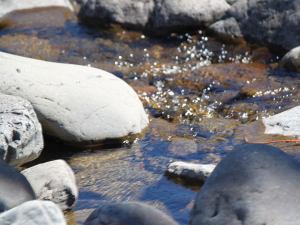'Give hunters a say on conservation' - ACT
ACT Party conservation spokesperson Cameron Luxton is calling for legislation that would ensure hunters and fishers have representation on the Conservation Authority.
 The Rangitikei Rivers Catchment Collective’s (RRCC) Mangawharariki sub-catchment group landowners have been monitoring the water quality monthly since January 2020.
The Rangitikei Rivers Catchment Collective’s (RRCC) Mangawharariki sub-catchment group landowners have been monitoring the water quality monthly since January 2020.
Investment by landowners to keep stock and sediment out of the Rangitikei River and its tributaries has been given the big tick from a population of Dwarf Galaxiids, which require healthy streams to survive.
Dwarf Galaxiids are small non-migratory fish native to New Zealand. According to the Department of Conservation (DOC), they belong to an ancient, scaleless fish family called Galaxiidae. Unlike whitebait, which migrate to see, some non-migratory Galaxiid species live out their entire life in the stream or river in which they hatch.
The Rangitikei Rivers Catchment Collective’s (RRCC) Mangawharariki sub-catchment group landowners fenced the main part of Mangawharariki River that runs through their farms and have been monitoring the water quality monthly since January 2020.
The Galaxiids were discovered during a stream health assessment workshop the farmer-led RRCC Mangawharariki group organised to look in-depth at stream health, by counting the number of macroinvertebrates within a section of the river.
Greg Clifton, Mangawharariki sub-catchment group chairperson, says it was “extremely rewarding” to find the fish.
“Landowners fenced the main river some time ago as a freshwater requirement and a few of us dedicated landowners have also been fencing along the tributaries of the river to keep sediment and nutrients out of the water,” Clifton says.
“This fish are not well-known, and it was hugely exciting to find the small fish,” says Louise Totman, RRCC catchment coordinator.
Since 2018, the collective has built a significant regional dataset of water quality monitoring.
Three to five years of data have been collected from nine of its 22 sub-catchment groups, and this is set to continue growing year-on-year.
“The fish are a good indicator of healthy water, and a lack of predators,” Totman says.
“Galaxiids are a perfect snack for introduced trout, but because of the old hydro power dam at the bottom of the Mangawharariki River, trout can’t get up this far,” she says.
RRCC is a farmer-led collective of rural residents and landowners working together with funding from the Ministry for Primary Industries (MPI) to protect the environment and enhance biodiversity in the Rangitikei, Turakina and Whangaehu River catchments. RRCC farmer members undertake monthly water quality monitoring at 88 sites across its 700,000ha catchment.
With the current situation in the European farm machinery market being described as difficult at best, it’s perhaps no surprise that the upcoming AgriSIMA 2026 agricultural machinery exhibition, scheduled for February 2026 at Paris-Nord Villepinte, has been cancelled.
The Meat Industry Association of New Zealand (MIA) has launched the first in-market activation of the refreshed Taste Pure Nature country-of-origin brand with an exclusive pop-up restaurant experience in Shanghai.
Jayna Wadsworth, daughter of the late New Zealand wicketkeeper Ken Wadsworth, has launched an auction of cricket memorabilia to raise funds for I Am Hope's youth mental health work.
As we move into the 2025/26 growing season, the Tractor and Machinery Association (TAMA) reports that the third quarter results for the year to date is showing that the stagnated tractor market of the last 18 months is showing signs of recovery.
DairyNZ chair Tracy Brown is urging dairy farmers to participate in the 2026 Levy vote, to be held early next year.
Beef + Lamb New Zealand (B+LNZ) is calling for nominations for director roles in the Eastern North Island and Southern South Island electoral districts.